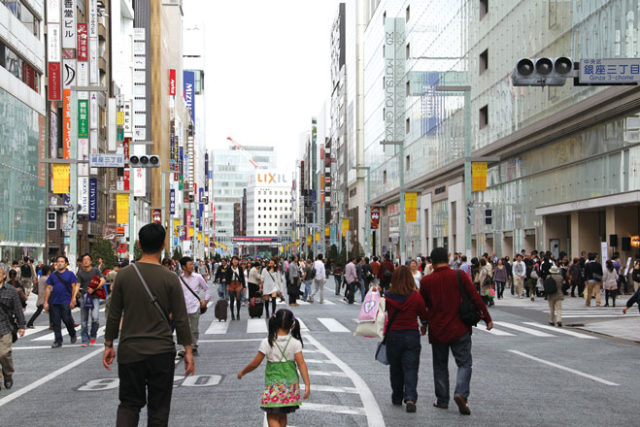By Yukiko Tanaka
For The North American Post
To orient yourself, you might find Chuo-dori, the main thoroughfare that goes through Ginza from northeast to southwest and Harumi-dori that runs diagonally. More commonly, however, people identify where you are in Ginza by giving numbers from 1-chome to 8-chome, which is almost to the Shimbashi Stations of the JR line. Streets crossing Chuo-dori often have names of flowers and trees, Yanagi-dori (Willow Street), for example. These streets, as well as narrower ones crossing them, are your best bet in taking a walk and enjoying yourself. The essence of Ginza, in my opinion, is along these narrower streets, not broad ones.
The name of Ginza came from the fact that the shoguns’ government placed a mint here (at around 2-chome) and it was gin (silver) that was used for coins of day-to-days use (za refers to medieval artisans’ union). Like Nihonbashi, Ginza in the Edo era was the heart of the bustling downtown, but as the modern era of Meiji ushered in, westerners, along with the culture they brought with them, were seen earlier than any other spots.
After a big fire, which had burned much of the Ginza area down in the fifth year of Meiji, brick houses appeared even though they did not suit Japan with its humid summers. The streets became twice as wide, too. Ginza was thus reborn as a western-influenced town where shops carried luxury goods both imported and traditional, just as it does now. Since Japan’s first locomotives ran between Yokohama (south of Tokyo with a port open for foreign ships) and Shimbashi, foreign visitors to Tokyo saw Ginza before anywhere else.
To cover much of Ginza on foot, you need not more than an hour. You should meander about and you should pick not its broad main streets but its side streets. There, you will find boutiques, galleries, bars, coffee houses and restaurants serving food from all over the world. As an old term gin-bura (gin is from Ginza, bura is “strolling”) suggests, Ginza is where you should stroll without specific purposes, that’s what people did and still do. Its main streets are made off limit to vehicles and allow only pedestrians on weekends.
Although it has a few competitors elsewhere today, like Aoyama and Roppongi, Ginza is the oldest of the fashionable shopping districts and it comes with history and a unique charm. For example, Wako Building at its heart on 4-chome is a pre-war construction, having somehow escaped US firebombing. Well maintained and with the beauty coming from ages, it is Ginza’s landmark; people often designate this building as a meeting spot. Mitsukoshi Department Store with a bronze statue of a lion is another meeting spot favored by Tokyoites.
If contemporary architecture is your interest, Louis Vuiton, Cartier, Mikimoto Pearl, DeBeers (both 2-chome) and Channel (3-chome) are all in the buildings architecturally noteworthy for their original or daring designs.
Real estate in Ginza is valuable, of course, but during the early to mid-‘80s, price per square meter hit the ceiling, arguably highest in the world. Men equipped with business accounts entertained bankers, government officials and each other nightly and extravagantly, making Ginza restaurants, bars and nightclubs very busy.
After several years of a maddening frenzy with rapid economic growth, however, Ginza has quieted down. Some establishments have closed and the “butterflies of the night,” as women in the water trade were called, have left. To me, Ginza in this quieted-down state is more attractive with its original charm still there. Today we can enjoy restaurants that serve excellent food of all kinds—Japanese, western, Chinese, what not–and many of them offer very reasonable fixed menu lunches.
Ginza has two sections, west and east of Showa-dori. Kabuki Theater is in the east section, or Higashi-Ginza, being at the intersection of 4-chome and Harumi-dori. Following the example of the Opera in Paris, the theater opened in the 22nd year of the Meiji era with a capacity of 180 seats plus 300 standing rooms in its three-storied building. The theater was destroyed three times–once by a big fire during the Taisho era, then at the time of the Great Kanto Earthquake and finally by fire bombings toward the end of WWII. It was rebuilt in concrete and then a few years ago it underwent yet another reconstruction. Luckily, the front of the building is exactly as it was in its original traditional style and colors of its unique red against stark white. It now has a tall building behind, presumably to rent and earn income.
Kabuki theater is open all year-round with different programs monthly. One can buy a seat inexpensively to see only one or two scenes, which sometimes is enough to get the flavor of its spectacular stage. Sitting through the entire production, which is very long, is not for everyone.
[Editor’s Note]
This series will be published every week. The writer can be reached atytanaka03@gmail.com.






